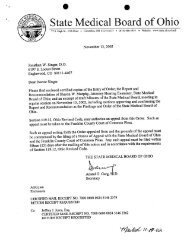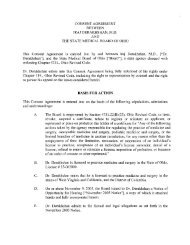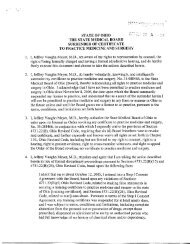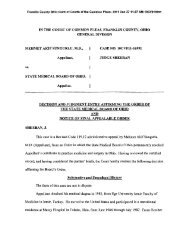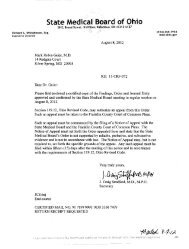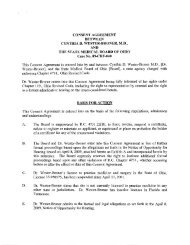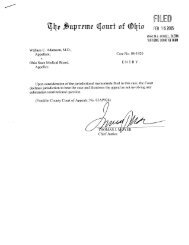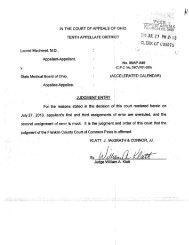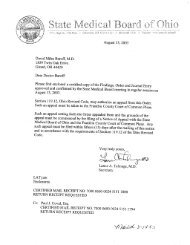CONSENT AGREEMENT BETWEEN - State Medical Board of Ohio ...
CONSENT AGREEMENT BETWEEN - State Medical Board of Ohio ...
CONSENT AGREEMENT BETWEEN - State Medical Board of Ohio ...
Create successful ePaper yourself
Turn your PDF publications into a flip-book with our unique Google optimized e-Paper software.
Matter <strong>of</strong> Kyle Elliott Hoogendoorn, D.P.M. Page 45<br />
until you step up a step, internship, residency, and then you teach the guy<br />
beneath you.<br />
(Tr. at 824)<br />
Testimony <strong>of</strong> Dr. Chelimsky<br />
110. Dr. Chelimsky testified that he had had trouble understanding why Dr. Hoogendoorn was<br />
in the PCC fellowship because fellows “normally would be trained to do things they’re<br />
going to do in the future.” However, Dr. Chelimsky testified that a podiatrist would not<br />
perform trigger point injections because there are no trigger points in the foot or the<br />
supporting structures <strong>of</strong> the foot. Dr. Chelimsky further testified that, if a technique would<br />
be beyond the scope <strong>of</strong> a podiatrist’s eventual practice, the podiatrist should not be taught<br />
that technique in a fellowship. Moreover, Dr. Chelimsky testified that the standard <strong>of</strong><br />
practice is that a fellowship teaches only those things that may be used by the fellow in his<br />
or her area <strong>of</strong> licensure. (Tr. at 1838-1839, 1894, 1983)<br />
In addition, Dr. Chelimsky testified that, if Dr. Griffin or Dr. Leak had always been<br />
at Dr. Hoogendoorn’s side when he performed a procedure and had always reviewed and<br />
approved Dr. Hoogendoorn’s treatment plans, it would not change his opinion concerning<br />
Dr. Hoogendoorn’s participation in the fellowship. Dr. Chelimsky testified:<br />
I think the fundamental question I have is was this just a way <strong>of</strong> getting more<br />
procedures done and just get more money passed through, or was there a true<br />
fellowship program happening with true education, some percentage <strong>of</strong> time<br />
allotted to Dr. Hoogendoorn that would be his fellowship time? The whole<br />
thing has a very unusual appearance to it, as best I can gauge from the notes,<br />
from ’99 to 2001.<br />
(Tr. at 1992)<br />
Furthermore, Dr. Chelimsky testified that, the only attestation in the patient records<br />
concerning supervision had been a line dictated by Dr. Hoogendoorn that Dr. Leak or<br />
Dr. Griffin had been supervising. Dr. Chelimsky testified that “that would be entirely<br />
inadequate in any medical record review.” Dr. Chelimsky testified that an attestation is<br />
required by the supervising physician that he or she was present at the time <strong>of</strong> the<br />
procedure. Ideally, the supervising physician’s note would also include information<br />
concerning the patient’s progress or “[s]ome evidence that there was some thought put in<br />
by the person doing the training.” (Tr. at 1831-1834)<br />
111. With regard to Dr. Chelimsky’s knowledge <strong>of</strong> the PCC fellowship program, the following<br />
exchange took place:<br />
Q. [By Mr. Graff] The fellowship program hours <strong>of</strong> Dr. Griffin were accepted by<br />
the American <strong>Board</strong> <strong>of</strong> Anesthesia for the purposes <strong>of</strong> board certification<br />
examination in pain medicine. Are you aware <strong>of</strong> that?



